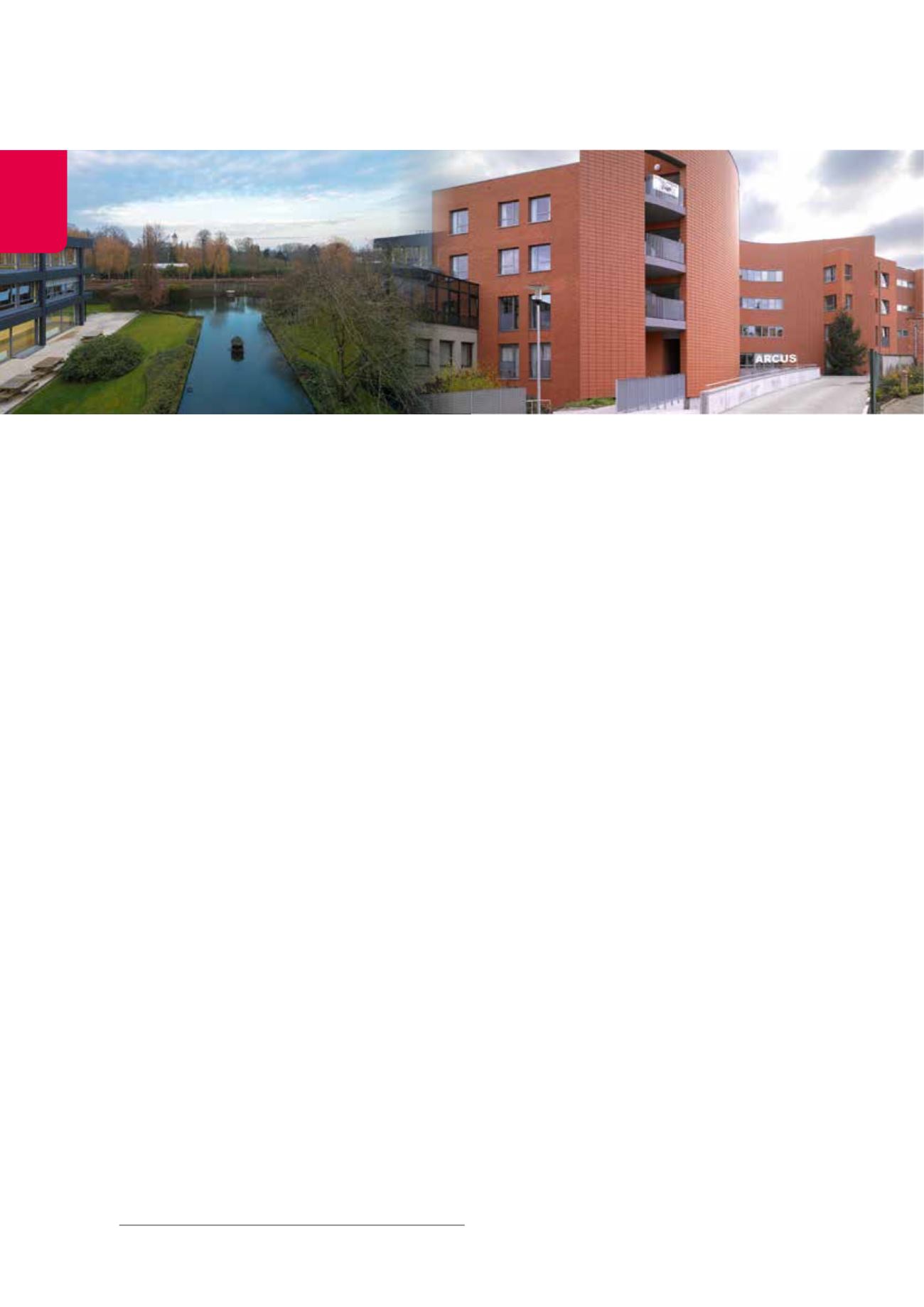

Arcus, Brussels (BE)
Prins Boudewijnlaan 41, Edegem (BE)
PROPERTY REPORT /
Market characteristics
Supply
During 2014, 178,000m² of new offices were delivered to the
Brussels market. Just 20% correspond to speculative investments,
confirming the trend recorded since 2011 of an extremely low num-
ber of “at risk” deliveries.
Between 2015 and 2016, 188,000m² are expected on the market,
over 40% of which are speculative.
Vacancy
In 2014, rental vacancy fell slightly in the Brussels office mar-
ket, from 11.1% at 31.12.2013 to 10.6% at 31.12.2014. This fall can be
explained, on the one hand, by a low level of new speculative
building coming onto the market and, on the other hand, by the
reconversion of office buildings into other uses (residential, hotels,
nursing homes, etc.).
Significant disparities exist between districts. The CBD, for instance,
records a “balanced” vacancy rate of 5.8%, while the periphery is
struggling to reduce its vacancy, which remains at 25%. Disparities
are also evident between types of buildings, with availability of
“grade A”
1
buildings steadily falling.
The office investment market in Brussels
In 2014, €1.8 billion was invested in the office segment in Brussels
– the highest level recorded since the financial crisis. The sale
by Cofinimmo, during the second quarter, of the shares of the
company Galaxy Properties, owner of the North Galaxy building
(Brussels North), to ATP and AXA Belgium for €475 million, repre-
sents the largest real estate transaction on the Belgian market
for a single building. Other notable transactions occurred in 2014,
including the purchase by Hannover Leasing and a Chinese investor
of the Covent Garden building (Brussels North) let to the European
Commission for €270 million, the purchase by GLL of the Platinum
building (Louise District) for €90 million and the purchase by
Intégrale of the building developed for the Brussels environmental
protection authority (Brussels North) for €72 million.
Although well-located buildings with long leases are still pre-
ferred by investors, more opportunistic investments were also
observed during the second half of the year. The purchase by Ares
Management of the Pegasus property portfolio (Brussels Periphery)
for €87 million is a good example.
“Prime” yields for offices in Brussels continue to be under pressure.
At the end of 2014, they stood at 6.25% for assets leased under
3/6/9-year leases and 5% for assets leased long term.
Healthcare real estate in Belgium,
France, Germany and the
Netherlands
Sources : DTZ, E&Y, Healthcare Property.
Demographic trends and budgetary constraints
The ageing of the population is a growing trend in most European
countries. In Belgium, Germany, France and the Netherlands, for
instance, the proportion of the population aged over 80 is set to
reach between 6% and 8% by 2030 depending on the country.
Although the number of independent seniors within this category is
up, the ageing of the population will nevertheless be accompanied
by a considerable increase in the number of dependent elderly,
leading to a greater need for specialised healthcare facilities and,
consequently, beds. It is estimated that between 2013 and 2020,
the need for beds is set to rise by 7% in France, by 14% in Belgium
and by 22% in Germany. Only the Netherlands is set to see its sup-
ply of beds decline, due to financial constraints.
At the same time, healthcare expenditure accounts for an increas-
ing share of GDP: in Belgium, France, Germany and the Netherlands,
this share is between 10% and 12% depending on the country. In a
context of budget restrictions, private players are increasingly tak-
ing over from the public sector in this segment. We are also seeing
a tendency to steer long-term patients or less complex cases to
less technical and less expensive establishments. The “Zelfstandig
BehandelCentra” segment, or medium-sized private clinics special-
ising in less complex medical disciplines (dermatology, ophthalmol-
ogy, orthopaedics, etc.), is expanding rapidly in the Netherlands.
Operators in the healthcare sector
Three types of operators exist in the healthcare sector: public oper-
ators, operators from the non-profit sector and private operators.
The breakdown in market share between these various players
varies from one country to the other. In the nursing and care homes
segment, Belgium has the most balanced situation, with each type
of operator representing a third of the market there. Conversely,
the non-profit sector has a practical monopoly in the Netherlands.
Germany and France have intermediary situations.
1
Grade A : new development or renovation according to the latest standards,
including sublet spaces in new/renovated buildings, which have not been
previously occupied.
86

















